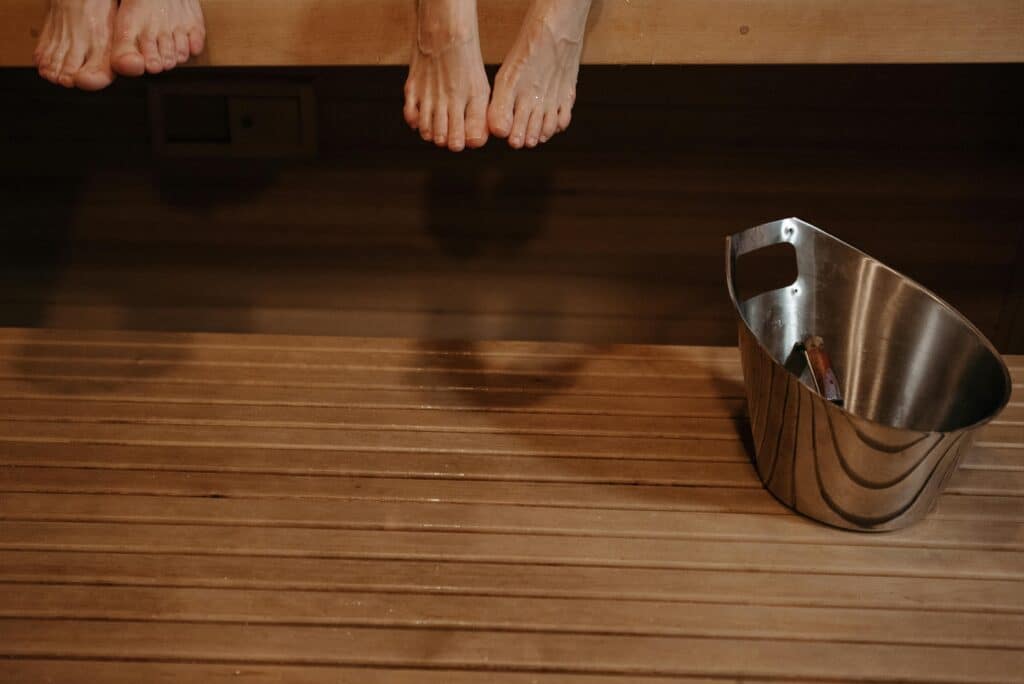How do saunas help with muscle recovery and relaxation?

Saunas have long been a staple in wellness routines, offering warmth and tranquility. They are not only a trend, as their health-promoting benefits have been scientifically proven many times. Understanding how saunas contribute to muscle recovery and relaxation can help you make the most of your sauna experience.
How do saunas help you achieve peacefulness of the mind and body? Keep reading and find out how saunas help you de-stress and relax.

1. Saunas Help With Muscle Recovery
There are multiple ways in which saunas can help with muscle recovery. Here is a short breakdown of all the important aspects of how high heat helps with blood circulation and inflammation.
1.1 Increased Blood Circulation and Oxygen Flow
One of the primary ways saunas help with muscle recovery is through improved blood circulation. The heat from a sauna causes blood vessels to dilate, increasing blood flow and delivering more oxygen and nutrients to tired muscles. This process helps repair micro-tears in muscle fibers, which will reduce the necessary recovery time.
A study by Ahokas et al. from 2022 found that a single session in an infrared sauna significantly helped with muscle recovery of 16 basketball players, after an intense exercise program (1).
Read more about different types of saunas in our article: “Which sauna is best for weight loss?”.
1.2 Reduced Muscle Soreness and Inflammation
Saunas also play a crucial role in reducing muscle soreness and inflammation. The heat experienced in a sauna helps to relax tense muscles and lessen the pain of exercise. Regular sauna sessions can significantly decrease delayed onset muscle soreness. This allows you to recover quickly and exercise more regularly.
A study by Toro et al. found that high-heat saunas can even help with building muscle after 12 sessions. 12 healthy young men participated in the study, and after two weeks, they had an increase in muscle mass and bone mineral content, without changing their diet or habits. More research is needed, but it seems that a regular visit to the sauna can also help preserve and build muscle and bones (2). This most likely happened because saunas help with quicker muscle repair and increased blood flow.
Check out this video that visually explains all of the benefits a sauna session has for your sore muscles:
2. Saunas Promote Relaxation and Mental Clarity
Another important aspect of saunas is the benefits they offer for your mental health. It’s not always about being physically fit, and we often forget about our mental state. Saunas can help us relax and have a much-needed mental detox. Keep reading and discover how saunas help us achieve mental clarity.
2.1 Stress Reduction and Mental Clarity
Beyond physical benefits, saunas also offer mental health advantages. The peaceful environment of a sauna promotes relaxation, helps to reduce stress levels, and improves mental clarity. The quiet, warm space allows for a meditative experience and quickly deletes the stressors of our busy daily lives.

2.2 The Role of Endorphins and Improved Mood
Sauna sessions trigger the release of endorphins, the body’s natural feel-good chemicals. This release not only enhances mood but also provides a sense of well-being and relaxation. Japanese scientists proved that three sauna sessions, with a cold water session, help people achieve an increased state of happiness, called the “totonou” state. Scientists recorded the brain waves of study participants and found they were significantly more relaxed before and after going to a combination of a sauna and an ice bath (3).
Read more about ice bath benefits in our article: “Benefits of Ice Baths for Wellness”.
How To Use Saunas After Working Out?
Now that you know how saunas help us relax and ease muscle pain, you probably want to go as soon as possible. And you should! Here are a few tips to get you started.
3.1 Effective Timing and Duration for Optimal Results
To maximize the benefits of sauna therapy effects, it’s essential to use them correctly. Ideally, a sauna session should last between 15 to 20 minutes, allowing the body to fully experience the heat’s therapeutic effects.

3.2 Safety Considerations and Tips for Beginners
While saunas are generally safe, it’s important to stay hydrated and listen to your body. Beginners should start with shorter sessions and gradually increase the duration as they get used to the heat.
Here are some important tips:
- Hydrate well before, during, and after your sauna session.
- Start with shorter sessions, gradually building up your tolerance to the heat.
- Wear proper sauna clothing, such as light cotton fabrics. Do not wear tight gym clothes in the sauna!
- If you start feeling unwell or uneasy, leave the sauna immediately.
Always consult with a healthcare provider if you have any underlying health conditions before incorporating saunas into your routine.
For more insights, explore our detailed guide on sauna benefits: “How long should I stay in a sauna for weight loss?”.
Literature references
Ahokas EK, Ihalainen JK, Hanstock HG, Savolainen E, Kyröläinen H. A post-exercise infrared sauna session improves recovery of neuromuscular performance and muscle soreness after resistance exercise training. Biol Sport. 2023 Jul;40(3):681-689. doi: 10.5114/biolsport.2023.119289.
Toro V, Siquier-Coll J, Bartolomé I, Pérez-Quintero M, Raimundo A, Muñoz D, Maynar-Mariño M. Effects of Twelve Sessions of High-Temperature Sauna Baths on Body Composition in Healthy Young Men. Int J Environ Res Public Health. 2021 Apr 22;18(9):4458. doi: 10.3390/ijerph18094458.
Chang M, Ibaraki T, Naruse Y, Imamura Y. A study on neural changes induced by sauna bathing: Neural basis of the “totonou” state. PLoS One. 2023 Nov 27;18(11):e0294137. doi: 10.1371/journal.pone.0294137.







